I recently wrote quite a bit about Snowflake – and their strategy for building a “data ecosystem”. It’s a big idea and my explanation was to think about Snowflake’s business model as three complementary platforms.
I thought that was pretty solid. And, arguably, a better explanation of their business model than I could find elsewhere. The whole idea of a data ecosystem is compelling but still evolving.
Snowflake Is a Great Example of a Coordination Platform in Data Intelligence
Snowflake uses interesting language when talking about its use cases. Here is how they describe their key activities:
- Storing data. Data warehousing is the company’s core use case.
- Standardizing data. This reduces errors and lowers costs. The company is doing lots of data engineering.
- Consolidating data (i.e., data warehouses, data lakes). The company says it helps corporations have “a single source of truth”.
- Sharing and discovering data. The company sets the rules for accessing and sharing data. Governance and security are key activities. This can be within a company and between a company and its suppliers, partners, customers and others.
- Analyzing data. The consolidated data can be mined for meaningful insights. This enables faster decision making. The company is doing lots of data analytics.
- Buying and selling data.
- Developing data-rich apps.
Most of these use cases are about interactions. The company is all about users and data interactions, which means a platform business model. It gathers data from many users within a company. And from associated companies. It standardizes the data. It gives access to data to different users. It enables the sharing of data. So it’s a platform but what type?
Note that points 1-5 are about coordination, collaboration and standardization (of data). And that is #2 on my list of 5 platform types. And this is what most enterprise software companies do.
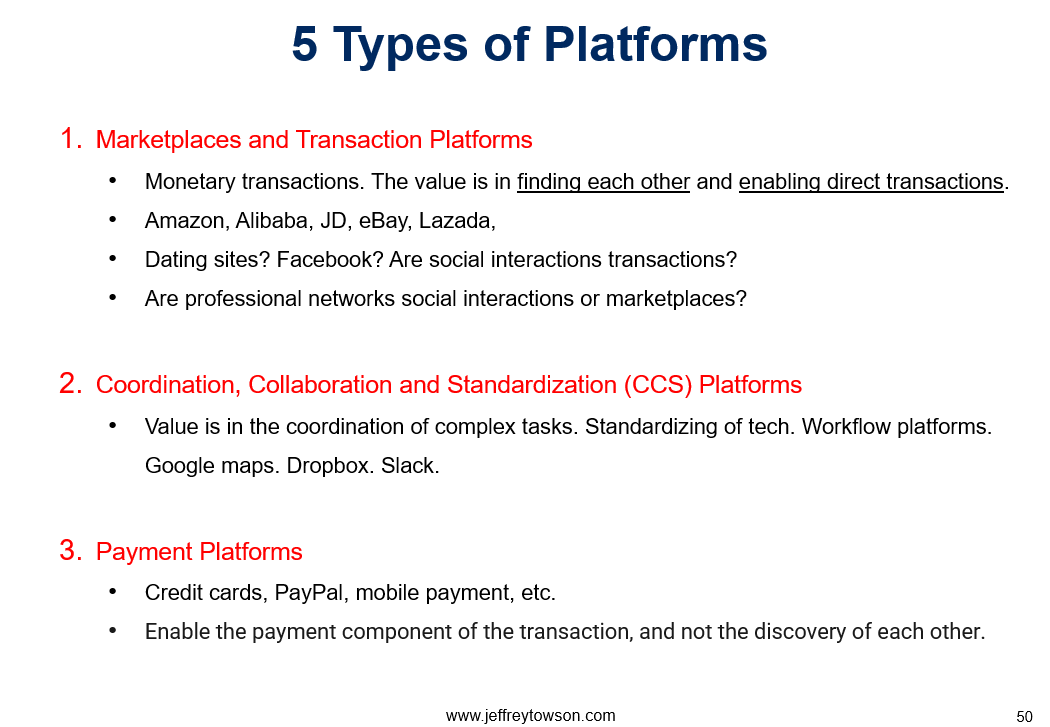
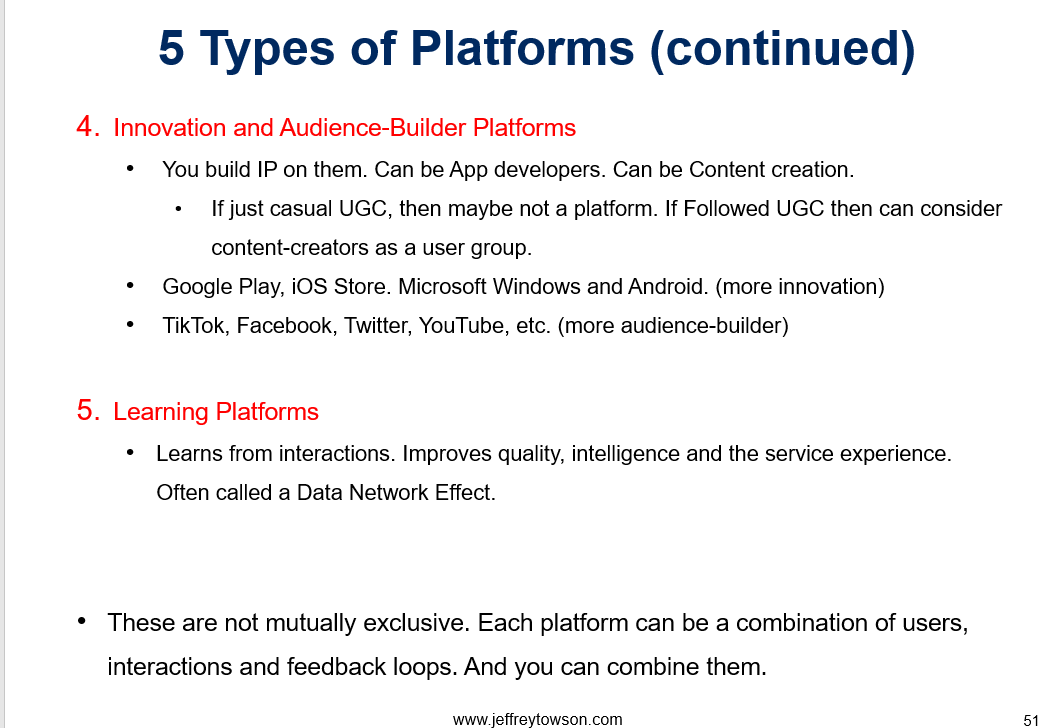
Here is my standard definition for a coordination, collaboration and standardization (CCS) platform:
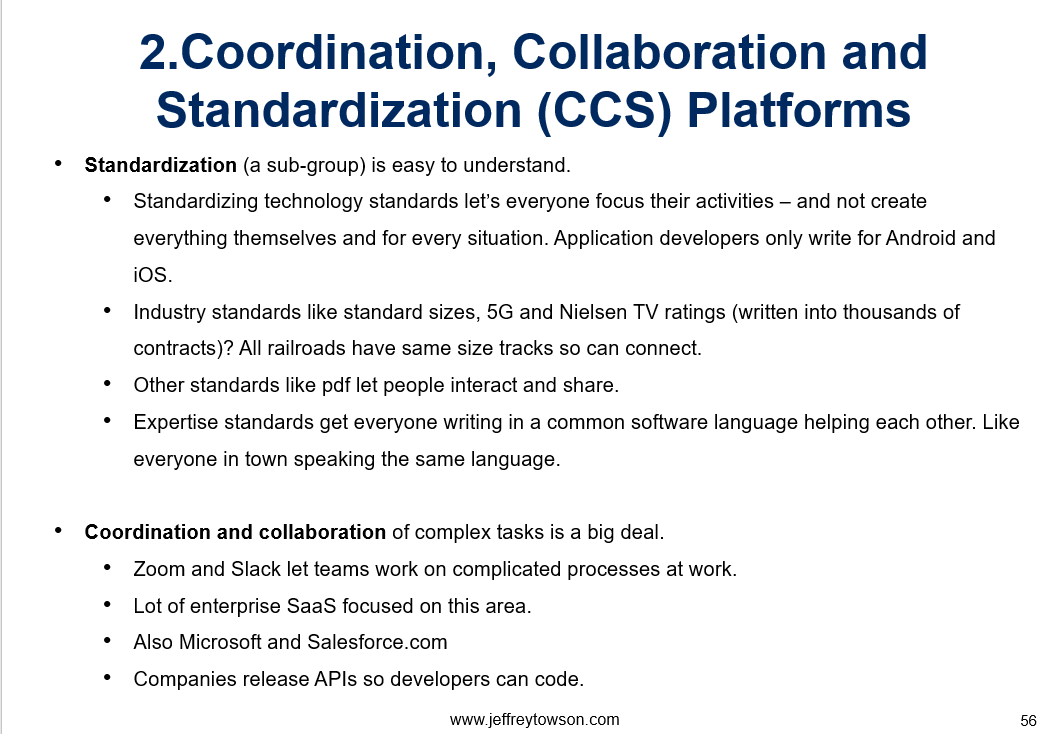
But I’ve never really broken CCS platforms into sub-types like I have for marketplace platforms. I’ve now started breaking this into 4 sub-types of CCS platforms. They are:
- Communication. Zoom, Slack, etc.
- Data Intelligence. Snowflake and Confluent.
- Team Projects. Manual and complicated projects like architecture, media creation, software development.
- Operational Automation.
So back to Snowflake.
What is the core, foundational platform of Snowflake? It’s a CCS platform for Data Intelligence. Look at the company’s description of its activities again.
- Storing data. Data warehousing is the company’s core use case.
- Standardizing data. This reduces errors and lowers costs. The company is doing lots of data engineering.
- Consolidating data (i.e., data warehouses, data lakes). The company says it helps corporations have “a single source of truth”.
- Sharing and discovering data. The company sets the rules for accessing and sharing data. Governance and security are key activities. This can be within a company and between a company and its suppliers, partners, customers and others.
- Analyzing data. The consolidated data can be mined for meaningful insights. This enables faster decision making. The company is doing lots of data analytics.
The trick to understanding Snowflake is actually in defining the user groups on the platform. Snowflake talks about:
- Corporate customers – but the platform users are usually individuals or teams within companies.
- Corporate partners – which can include external users such as customers and suppliers.
- Data providers.
- Data consumers.
- Application developers.
But that is pretty confusing. I use the following definitions:
- Internal providers and users of data. Which can be human or digital agents.
- External providers and users of data. Which can be customers, partners, suppliers and so on. And they can be human or digital agents.
When you look at it that way, you get:
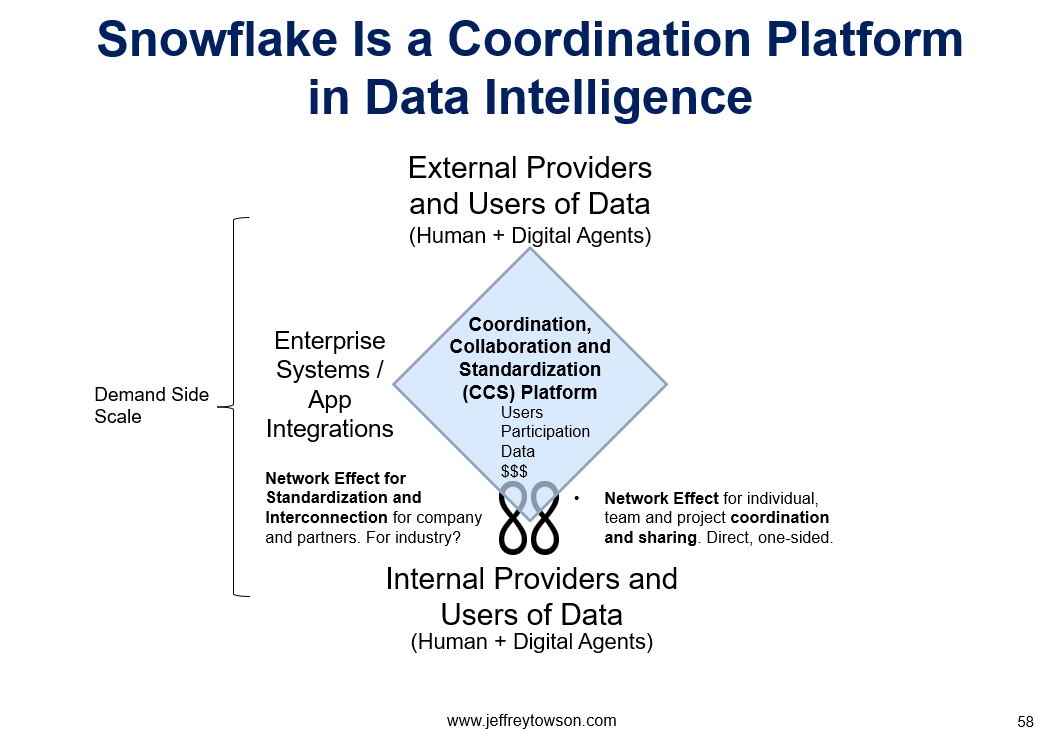
And we can see two network effects in the core platform (see the infinity signs):
- Direct network effect between internal providers and users of data.
- Standardization network effect across the organization and its related companies.
That’s how I view Snowflake. That is the vast majority of their business model and what is going on.
Second to this, they are also building out an Innovation Platform that connects their current users with app developers.
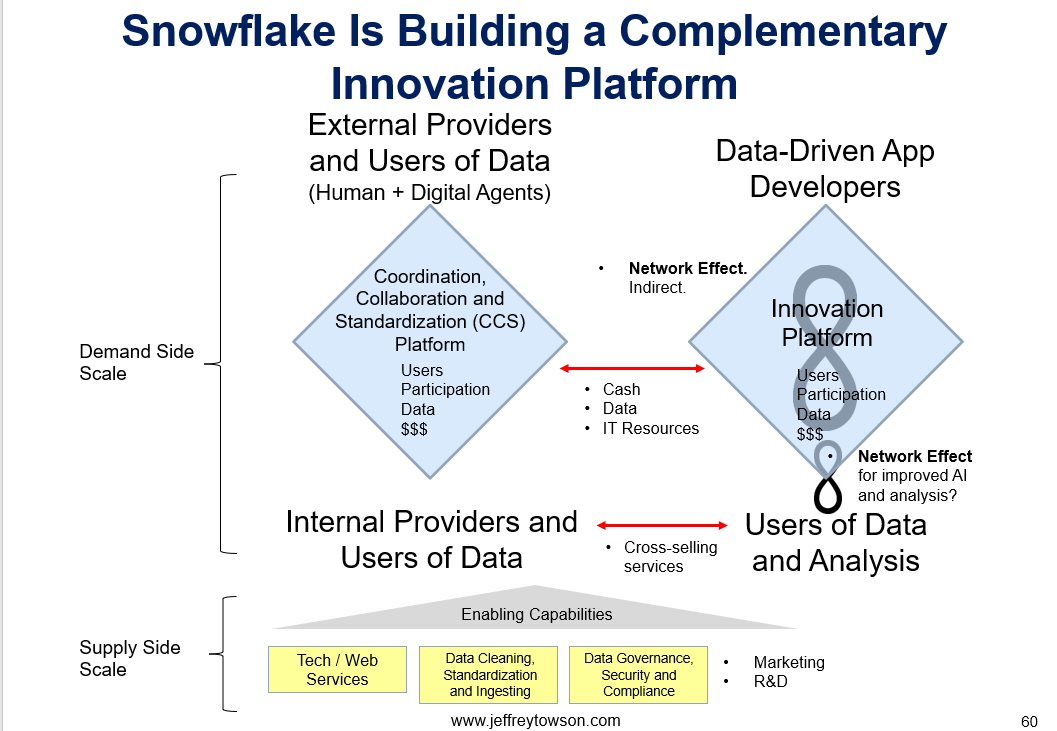
They are also starting to build a data marketplace platform. Those three platforms gets you Snowflake’s stated goal – which is to “consolidate data into a single source of truth, to derive meaningful insights, build data-driven apps and share data inside and outside of company.”
You can see all three platforms in that statement.
Standard Questions for Collaboration, Coordination and Standardization (CCS) Platforms
These are 4 types of CCS platforms:
- Communication. Zoom, Slack, etc.
- Data Intelligence. Snowflake and Confluent
- Team Projects. Manual and complicated projects like architecture, media creation, software development.
- Operational Automation.
And you can see the differences when you start running through checklists for CCS. Here are some of my standard questions.
- Is the data intelligence coordination happening within the company? Or between companies? Or across an industry or ecosystem?
- Are the company’s users within one location? Across a region? National? Globally? How much of the workforce distributed and virtual?
- Is coordination happening between human or digital agents?
- How much of data analysis and intelligence is via AI? How much data is required for this?
- What is the timing of the data intelligence interactions?
- Is data gathered in real-time?
- Is data analyzed in real-time?
- How does the network effect change with volume?
- How does value and/or utility increase for each user group? With increasing data, use cases, apps used, systems connected?
- How does value and/or utility increase for the company overall? With increasing data, use cases, apps used, systems connected?
- How does value and/or utility increase for connected companies? With increasing data, use cases, apps used, systems connected?
- How does value and/or utility increase for the industry or ecosystem? With increasing data, use cases, apps used, systems connected?
***
That’s it for Snowflake. And it tees up Confluent and Red Hat, which operate in the same space but have different answers to these questions.
I’ll cover that in Part 2. – Jeff
—–
Related articles:
- Confluent, Red Hat, and More on Coordination Platforms (2 of 2) (Asia Tech Strategy)
- Part 3: Snowflake’s Big Growth and Competition Questions (Pt 3 of 3) (Asia Tech Strategy – Daily Lesson / Update)
- Snowflake is Building 3 Complementary Platforms with 4 Network Effects (Pt 1 of 3) (Asia Tech Strategy – Daily Lesson / Update)
- Kingsoft Cloud and How to Think About Cloud Services in China (Asia Tech Strategy – Daily Lesson / Update)
From the Concept Library, concepts for this article are:
- Coordination Platforms
- Coordination Platforms: Data Intelligence
- Enterprise B2B
From the Company Library, companies for this article are:
- Snowflake
Photo by Zdeněk Macháček on Unsplash
——
